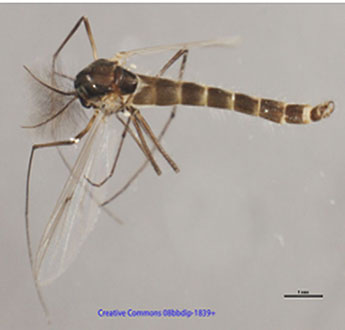Species 4t. Chironomus species NAII of Proulx et al. In BOLD Bin: BOLD:AAG5454Adult: Some data for males from BOLD specimens.
Male:
Adult male 08bbdip-1839+1234984344 from BOLD DatabaseA dark species: thorax dark brown, vittae and postnotum black. Abdomen dark brown, with narrow anterior pale region on segment I, and a posterior pale band on segments II-VII, becoming wider on segment VII. Anterior tibia paler basally, but becoming darker and femur and tarsi all darkened, no obvious beard; other legs all darkened. Wings pale, but anterior veins slightly darkened, particularly at crossvein.
Wing length about 4.75 mm, width abt. 1.15 mm, VR about 0.98.
Approximate leg measurements and proportions (micron):
| Fe
| Ti
| Ta1
| Ta2
| Ta3
| Ta4
| Ta5
| LR
| F/T
| BR
| PI
| 1200
| 1200
| 1800
| 1000
| 800
| 800
| 280
| 1.5
| abt 1
| low
| PII
| 1520
| 1440
| 950
| 400
| 240
| 200
| 180
| 0.7-0.75
| 1.05
|
| PIII
| 1400
| 1550
| 1210
| 790
| 550
| 400
| 220
| 0.75-0.78
| abt 0.9
|
| Female: Not knownPupa: not known Larva A medium salinarius-type larva, length about 11 - 13 mm.
The frontoclypeus is dark and the gular region is posteriorly darkened. The c2teeth of the mentum trifid tooth are almost completely separated from the c1 tooth (type III); 4th laterals reduced to about the same height as the 5th lateral teeth (type II).
Anterior margin of the ventromental plate is smooth, with about 51-52 striae reaching to about centre of the plate and with faint striae reaching at least half the remaining distance to anterior margin.
Pecten epipharyngis with 12-14 pointed and rather uniform teeth. Premandible with inner tooth about 1.9-2.7 times wider than the outer tooth, and slightly longer.
Antenna with A1 about 3.41 (3.25-3.50) times longer than wide; AR about 2.23 (2.06-2.38); ratio of segments (µm) 141 : 34 : 12 : 15 : 7.
The 3rd inner tooth of the mandible partially colored and fused to the lower margin (type IIB), at least 11 furrows on outer surface near the base. Cytology: Cytology of available specimens was not good. 4 polytene chromosomes, probably with the thummi arm combination AB, CD, EF, G.
Arm G often unpaired and with a virtually terminal nucleolus. Found in an oligotrophic lake at a depth of 4 m.Found: Alberta - Johnson Lake area, Banff Ntl. Pk. (51.198°N, 115.479°W)(GeneBank)
Ontario - Silver Lake(46.43°N, 81.03°W), Sudbury area. This larva does not correspond to any of the other currently known salinarius-type from North America or the Palearctic. [ Return to Index| Go to References ] |
